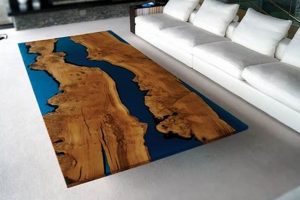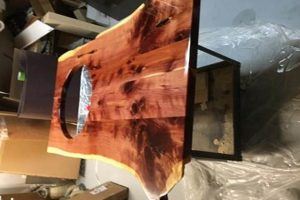Bespoke carpentry solutions crafted to precise specifications represent a distinct sector within the broader woodworking industry. This specialized field focuses on creating unique pieces, ranging from furniture and cabinetry to architectural millwork, tailored to meet individual client needs and preferences. These products are not mass-produced; instead, each item is meticulously designed and constructed, often incorporating specific materials, dimensions, and aesthetic details. For example, a homeowner might commission handcrafted kitchen cabinets designed to perfectly fit an unusual space and reflect a particular design style.
The significance of this approach lies in its ability to deliver unparalleled personalization and quality. It allows clients to obtain items that are perfectly suited to their requirements, unlike standardized products. Historically, this type of craftsmanship has been valued for its durability and artistic merit. Moreover, this personalized method supports skilled artisans and fosters a connection between the creator and the end-user, promoting sustainability and preserving traditional techniques.
The subsequent sections will delve into the intricacies of this woodworking process, examining the design phase, material selection considerations, fabrication techniques, and the application of finishes.
Essential Guidance
The following recommendations are provided to ensure a satisfactory experience when procuring bespoke woodwork. Adherence to these suggestions can contribute to a superior outcome, reflecting both the client’s vision and the artisan’s expertise.
Tip 1: Define Project Scope Precisely: Articulate requirements with thoroughness. Provide detailed measurements, sketches, and relevant design references to the artisan. This mitigates ambiguity and fosters accurate execution.
Tip 2: Establish a Realistic Budget: Understand that custom work often incurs higher costs than mass-produced alternatives. Factor in material expenses, labor hours, and potential design revisions when determining budgetary parameters.
Tip 3: Review Material Options Carefully: Wood selection significantly impacts the final product’s aesthetics, durability, and maintenance requirements. Discuss the pros and cons of various wood species and finishes with the artisan.
Tip 4: Request Detailed Design Renderings: Before fabrication commences, secure comprehensive design renderings. This provides a visual representation of the proposed piece, allowing for necessary adjustments and approvals.
Tip 5: Verify the Artisan’s Qualifications: Examine the artisan’s portfolio and request references from previous clients. This due diligence confirms their expertise and ensures a track record of successful projects.
Tip 6: Formalize Agreements with a Contract: A legally binding contract should outline the project scope, timeline, payment schedule, and dispute resolution mechanisms. This protects both the client and the artisan.
Tip 7: Maintain Consistent Communication: Throughout the fabrication process, maintain open and frequent communication with the artisan. This facilitates timely feedback and prevents potential misunderstandings.
By embracing these recommendations, clients can navigate the commissioning process with greater confidence, resulting in a custom woodwork piece that seamlessly integrates with their spatial and aesthetic preferences. The forthcoming section will focus on common challenges encountered and how to address them.
1. Precise Measurements
Accurate dimensional data forms the bedrock upon which the successful creation of customized wooden articles rests. In the realm of tailored carpentry solutions, the deviation from specified measurements, however minor, can yield significant functional and aesthetic impairments.
- Ensuring Structural Integrity
Precise measurements are paramount in maintaining structural integrity. Millimeter-level accuracy guarantees the appropriate fit and secure interlocking of components. Erroneous measurements can compromise load-bearing capacity, resulting in instability or premature failure of the woodworking product.
- Facilitating Seamless Integration
Custom carpentry often involves integrating pieces within pre-existing structures. Accurate dimensions are crucial for a seamless installation, preventing unsightly gaps or misalignments. For example, built-in shelving requires precise measurements to ensure a flush fit against walls and ceilings.
- Optimizing Material Utilization
Employing exact measurements minimizes material waste. By knowing the precise dimensions of each component, the artisan can optimize cutting layouts, reducing scrap and improving cost-effectiveness. This is particularly important when working with expensive or rare wood species.
- Maintaining Design Fidelity
Adherence to precise measurements ensures that the final product adheres to the original design specifications. Proportional accuracy is essential for achieving the intended aesthetic effect. Deviations from the design can result in visual disharmony and diminished client satisfaction.
In conclusion, meticulous dimensional accuracy is not merely a desirable attribute, but a fundamental prerequisite for the successful execution of individually designed woodworking projects. Each element, from structural soundness to aesthetic congruence, is dependent on the precision applied during the measurement phase.
2. Material selection
Material selection within individually designed woodworking represents a critical determinant of the final product’s aesthetic qualities, functional performance, and longevity. The choice of wood species, hardware, and finishing products exerts a direct influence on the piece’s structural integrity, resistance to environmental factors, and overall visual appeal. For instance, selecting a durable hardwood like oak for a high-traffic dining table ensures resistance to scratches and dents, while a softer wood like pine might be suitable for decorative elements where structural strength is less critical. The quality and appropriateness of the materials chosen directly impact the value and utility of the completed item.
The process of material selection requires careful consideration of several factors. The intended use of the piece dictates the required strength and durability. Environmental conditions, such as humidity and temperature fluctuations, necessitate selecting materials that can withstand those conditions without warping, cracking, or deteriorating. The desired aesthetic also plays a significant role, with different wood species offering a range of colors, grains, and textures. Furthermore, the cost of materials must be balanced against the client’s budget. The selection of hardware, such as hinges and drawer slides, also contributes to the overall quality and functionality. Inferior hardware can lead to premature failure, regardless of the quality of the woodwork itself.
In summary, the careful consideration of material selection is essential for a successful outcome. Selecting the appropriate materials requires a comprehensive understanding of the wood’s properties, the intended function of the woodworking piece, and the environmental conditions to which it will be exposed. This process can significantly contribute to the longevity, functionality, and aesthetic appeal of the final product. Failing to prioritize suitable materials compromises the overall quality and lasting value of the customized carpentry.
3. Design Refinement
Design refinement is an iterative process of improvement integral to bespoke carpentry. It constitutes a critical phase within individually designed woodworking, influencing both the aesthetic quality and functional suitability of the final product. The initial design concept, often derived from client specifications, undergoes progressive modification based on technical considerations, material constraints, and aesthetic principles. This refinement process aims to resolve potential structural weaknesses, optimize material usage, and ensure the design aligns with the client’s evolving vision. For example, a preliminary design for a custom bookcase might require adjustments to shelf thickness to accommodate anticipated weight loads, or modifications to door hinges to ensure smooth operation. The ultimate success of the project often hinges on the thoroughness of the design refinement phase.
The practical application of design refinement extends beyond addressing technical issues. It encompasses the integration of ergonomic considerations, such as adjusting countertop heights for optimal user comfort, and the incorporation of aesthetic elements that enhance the overall visual appeal of the piece. Moreover, this process often involves close collaboration between the designer, the artisan, and the client, fostering a shared understanding of the design intent and ensuring the final product reflects the client’s individual style. For instance, clients may suggest subtle changes to trim details or surface finishes to better match their existing decor, which are then seamlessly integrated into the design during the refinement phase. In essence, design refinement transforms a conceptual idea into a well-executed and highly personalized carpentry piece.
In conclusion, design refinement represents a cornerstone of individually designed woodwork. By systematically addressing technical challenges, integrating ergonomic considerations, and fostering client collaboration, this iterative process ensures that the final product is not only aesthetically pleasing but also functionally robust and perfectly tailored to the client’s needs. The absence of diligent design refinement can result in structural flaws, aesthetic inconsistencies, and ultimately, client dissatisfaction. Therefore, meticulous attention to this stage is paramount to the success of any custom carpentry project.
4. Skilled execution
Skilled execution is indispensable to individually designed woodworking, representing the critical link between design conception and tangible realization. The inherent complexity of custom projects necessitates a high degree of proficiency in various woodworking techniques, precision in tool handling, and an acute understanding of material properties. Without adept execution, even the most innovative design remains unrealized, or, worse, results in a flawed and structurally unsound product. Consider a meticulously designed dining table featuring intricate joinery; only a skilled artisan can precisely cut and assemble the components to ensure structural integrity and aesthetic harmony. The success of this example, and of individually designed woodworking in general, depends directly on the artisan’s mastery.
The implications of skilled execution extend beyond mere technical competence. It encompasses the ability to adapt to unforeseen challenges, creatively solve problems, and maintain consistent quality throughout the project. A common scenario involves encountering unexpected variations in wood grain or density, requiring the artisan to adjust cutting techniques or joinery methods to achieve the desired outcome. Moreover, skilled execution ensures efficient material utilization, minimizing waste and contributing to cost-effectiveness. Consider a curved banister crafted from a single piece of hardwood; its creation requires exceptional skill in bending and shaping the wood without compromising its structural integrity or visual appeal. The application of traditional techniques, combined with modern methods, ensures the durability and longevity of the finished piece.
In summary, skilled execution is not simply a component of bespoke wooden creations; it is the defining characteristic that transforms design into reality. It is the synthesis of technical proficiency, problem-solving acumen, and unwavering commitment to quality that distinguishes exceptional custom woodwork from ordinary craftsmanship. The challenges inherent in custom projects demand skilled artisans who can navigate complexity, adapt to unforeseen circumstances, and consistently deliver results that meet the highest standards. Ultimately, the lasting value and enduring appeal of individually designed woodworking are a direct reflection of the skill invested in its execution.
5. Durable Finishes
The application of robust surface treatments constitutes a fundamental aspect of bespoke wooden creations, safeguarding the underlying material from environmental stressors and enhancing its aesthetic appeal. These finishes are essential to the longevity and sustained visual integrity of individually designed woodwork.
- Protection Against Moisture
Finishes act as a barrier against moisture ingress, mitigating the risk of warping, swelling, and decay. In environments with high humidity, the selection of a moisture-resistant finish, such as marine-grade varnish or a catalyzed lacquer, is crucial. An example is a custom-built bathroom vanity, where a waterproof finish protects the wood from constant exposure to water and steam, preventing premature deterioration.
- Resistance to Abrasion and Impact
Durable finishes provide a protective layer against scratches, scuffs, and impacts that can mar the surface of wooden objects. Polyurethane coatings, known for their hardness and abrasion resistance, are often employed on high-use surfaces, such as dining tables and countertops. A well-applied finish can withstand daily wear and tear, preserving the original aesthetic of the wood.
- Ultraviolet (UV) Protection
Exposure to sunlight can cause fading and discoloration of wood over time. Finishes with UV inhibitors help to block harmful rays, preserving the wood’s natural color and preventing yellowing or bleaching. This is particularly important for pieces located near windows or outdoors, such as custom-built patio furniture. UV-resistant finishes extend the lifespan of the wood’s aesthetic appearance.
- Enhancement of Aesthetic Qualities
Finishes not only protect the wood but also enhance its natural beauty. Stains can be used to alter the color of the wood, highlighting the grain and adding depth. Clear coats, such as lacquer or varnish, provide a glossy or matte sheen, enhancing the wood’s natural texture. Proper application techniques, such as multiple thin coats, contribute to a smooth, even finish that showcases the wood’s inherent character.
In conclusion, durable finishes are integral to the enduring quality and aesthetic appeal of bespoke wooden creations. Their selection and application require careful consideration of environmental factors, usage patterns, and desired aesthetic outcomes. Well-chosen and expertly applied finishes protect against damage, enhance visual appeal, and contribute to the long-term value of individually designed woodwork.
6. Client collaboration
Client collaboration is a critical determinant of success. It is an interactive process involving shared vision, mutual understanding, and consistent communication throughout all phases of the project. Effective collaboration ensures that the final product aligns with the clients specific needs, aesthetic preferences, and functional requirements.
- Defining Project Scope and Objectives
Collaborative discussions are essential for precisely defining the scope of work and establishing clear objectives. Client input informs the design, material selection, and finishing details, preventing potential misunderstandings and ensuring accurate execution. For example, detailed conversations about intended use and placement allow the artisan to select appropriate materials and construction techniques, guaranteeing the longevity and functionality of the woodwork.
- Iterative Design Development
Collaboration fosters iterative design development through ongoing feedback and revisions. Clients review initial designs, offer constructive criticism, and participate in the refinement process, enabling the artisan to incorporate their preferences while adhering to structural and material constraints. This collaborative approach ensures the final design reflects the client’s vision, resulting in a personalized and satisfying outcome.
- Material and Finish Selection
The collaborative process extends to material and finish selection, empowering clients to choose options that align with their aesthetic preferences and functional needs. Artisans provide expert guidance on material properties, durability, and maintenance requirements, enabling clients to make informed decisions that enhance the overall quality and longevity. For example, a client might choose a specific wood species and stain color based on its visual appeal and resistance to wear and tear.
- Quality Assurance and Feedback
Client collaboration ensures continuous quality assurance through regular progress updates and feedback sessions. Clients have the opportunity to review the work at various stages, ensuring it meets their expectations and addressing any concerns promptly. This proactive approach minimizes errors and ensures the final piece aligns seamlessly with the original vision, enhancing client satisfaction.
These multifaceted collaborations ultimately guarantee the realization of bespoke wooden creations that not only meet but exceed client expectations. The interactive exchange of ideas, shared decision-making, and continuous feedback ensures that each project is a true reflection of the client’s vision, seamlessly integrated with the artisan’s expertise and craftsmanship.
Frequently Asked Questions
The following addresses common inquiries regarding bespoke carpentry. Clarification on these points facilitates informed decision-making for prospective clients.
Question 1: What distinguishes custom carpentry from mass-produced furniture?
Custom carpentry involves creating pieces tailored to specific requirements, whereas mass-produced furniture adheres to standardized designs. The former offers personalized dimensions, materials, and finishes, ensuring a unique and precisely fitted product. The latter prioritizes efficiency and scalability, resulting in more economical, yet less individualized, options.
Question 2: What factors influence the cost of commissioned woodwork?
Several elements contribute to the overall expense. These include the type and quantity of materials used, the complexity of the design, the labor hours required for fabrication, and any specialized finishes applied. Intricate designs involving rare wood species generally incur higher costs.
Question 3: How long does it typically take to complete a custom woodworking project?
The timeframe varies depending on the project’s complexity and scope. Simple pieces may be completed within weeks, while larger, more intricate projects can require several months. A detailed timeline should be established and agreed upon before commencement of work.
Question 4: What types of wood are commonly used in high-quality custom carpentry?
Durable hardwoods such as oak, maple, cherry, and walnut are frequently utilized for their strength, aesthetic appeal, and workability. Softwoods like pine and cedar are also employed, particularly for decorative elements or projects where structural strength is less critical.
Question 5: What is the best way to maintain custom wooden furniture and cabinetry?
Regular dusting with a soft cloth is essential. Avoid harsh chemical cleaners, which can damage the finish. Periodic application of furniture polish or wood conditioner can help maintain the wood’s natural luster and prevent drying. Promptly address spills to prevent staining.
Question 6: Is it possible to replicate an existing piece of furniture through custom carpentry?
Replicating existing pieces is feasible, provided detailed measurements and photographs are available. The artisan can then create a faithful reproduction, often with the option to incorporate modifications or improvements based on the client’s preferences. Copyright restrictions, if any, must be considered.
In summary, these FAQs serve to inform prospective clients about the fundamental aspects of commissioning bespoke carpentry, from cost considerations to maintenance practices.
The subsequent section will discuss common mistakes to avoid during the woodwork process.
Concluding Remarks
This exposition has illuminated diverse facets of tailored carpentry solutions. Attention was directed towards defining project scope, material selection criteria, design refinement processes, the execution of skilled craftsmanship, and the application of durable finishes. A comprehensive appreciation of these elements ensures a successful endeavor.
Properly executed, bespoke wooden creations represent a significant investment in enduring quality and personalized design. The value lies not only in the aesthetic appeal but also in the functional utility and lasting durability. Future clients should prioritize meticulous planning and diligent execution to realize the full potential of this exacting craft.







